Introduction to Global Tourism: Factors Influencing Tourism Trends
VerifiedAdded on 2023/06/04
|11
|2465
|354
Report
AI Summary
This report provides an in-depth analysis of the factors influencing global tourism, focusing on high attraction factors, challenges, and future opportunities. It examines the high attraction factors in Canadian tourism, such as recreation, community engagement, and economic development, while also addressing the lack of tourism measures globally, particularly in the Canadian Arctic region. The report incorporates Plog’s Continuum to understand tourist personalities, differentiating between psycho-centric and allocentric travelers and their destination preferences. It also discusses less popular destinations and how they can leverage their unique image. Furthermore, the report identifies future opportunities for tourism to boost economies and enhance social interactions, while also addressing challenges like environmental impact and the potential for overtourism to degrade the traditional image of tourism. The report concludes by emphasizing the importance of environmental, social, and behavioral factors in sustaining global tourism and highlights the need for government initiatives and regulatory frameworks to support sustainable expansion.
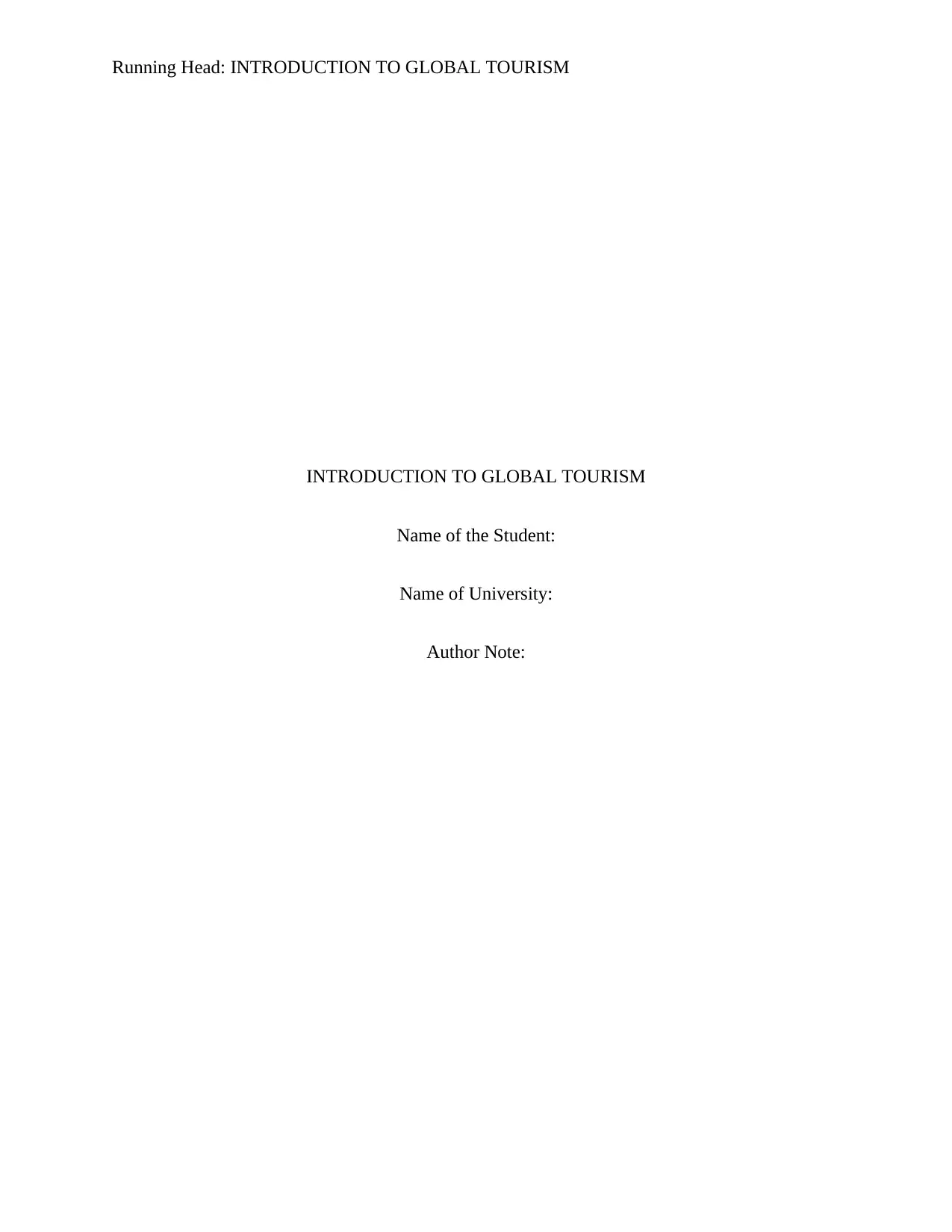
Running Head: INTRODUCTION TO GLOBAL TOURISM
INTRODUCTION TO GLOBAL TOURISM
Name of the Student:
Name of University:
Author Note:
INTRODUCTION TO GLOBAL TOURISM
Name of the Student:
Name of University:
Author Note:
Paraphrase This Document
Need a fresh take? Get an instant paraphrase of this document with our AI Paraphraser
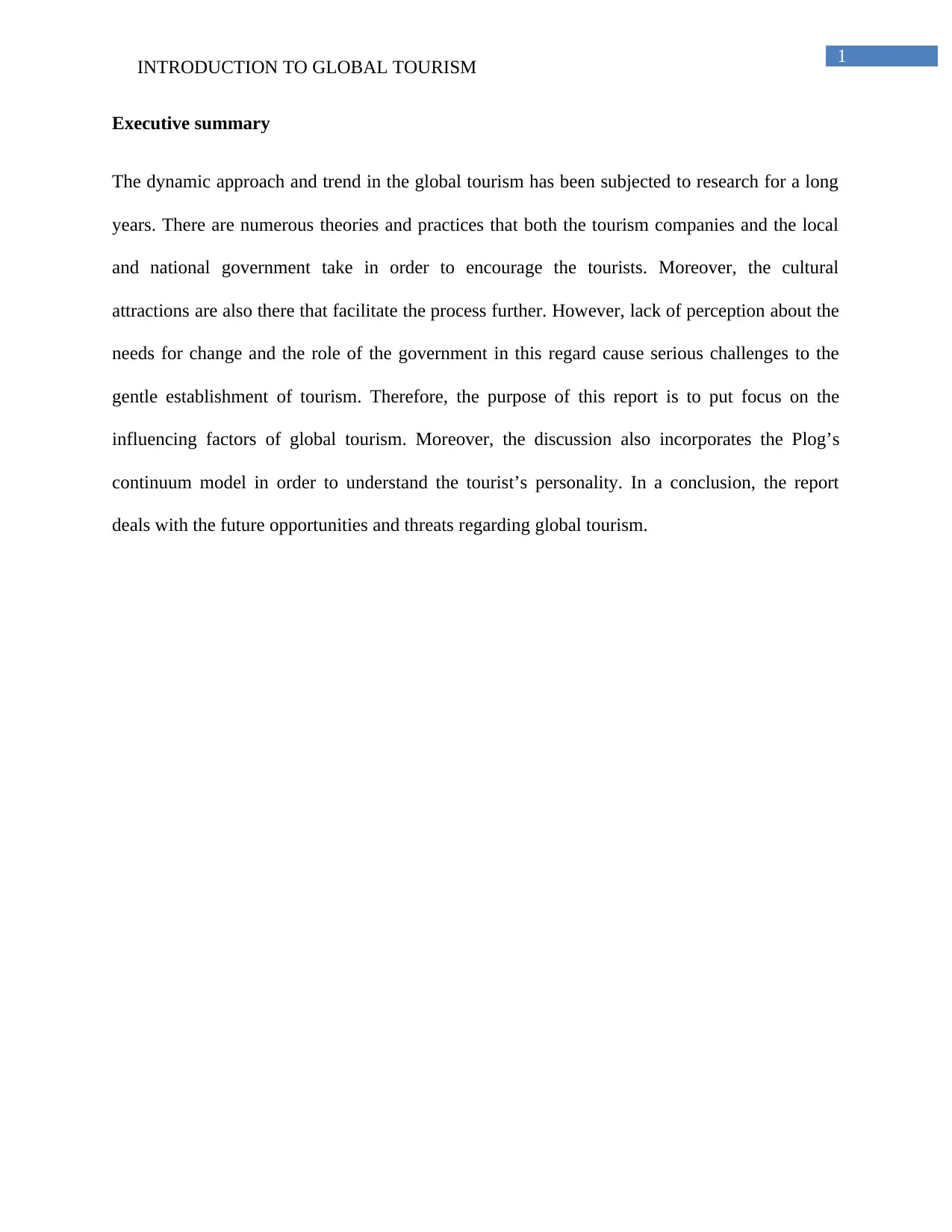
1
INTRODUCTION TO GLOBAL TOURISM
Executive summary
The dynamic approach and trend in the global tourism has been subjected to research for a long
years. There are numerous theories and practices that both the tourism companies and the local
and national government take in order to encourage the tourists. Moreover, the cultural
attractions are also there that facilitate the process further. However, lack of perception about the
needs for change and the role of the government in this regard cause serious challenges to the
gentle establishment of tourism. Therefore, the purpose of this report is to put focus on the
influencing factors of global tourism. Moreover, the discussion also incorporates the Plog’s
continuum model in order to understand the tourist’s personality. In a conclusion, the report
deals with the future opportunities and threats regarding global tourism.
INTRODUCTION TO GLOBAL TOURISM
Executive summary
The dynamic approach and trend in the global tourism has been subjected to research for a long
years. There are numerous theories and practices that both the tourism companies and the local
and national government take in order to encourage the tourists. Moreover, the cultural
attractions are also there that facilitate the process further. However, lack of perception about the
needs for change and the role of the government in this regard cause serious challenges to the
gentle establishment of tourism. Therefore, the purpose of this report is to put focus on the
influencing factors of global tourism. Moreover, the discussion also incorporates the Plog’s
continuum model in order to understand the tourist’s personality. In a conclusion, the report
deals with the future opportunities and threats regarding global tourism.
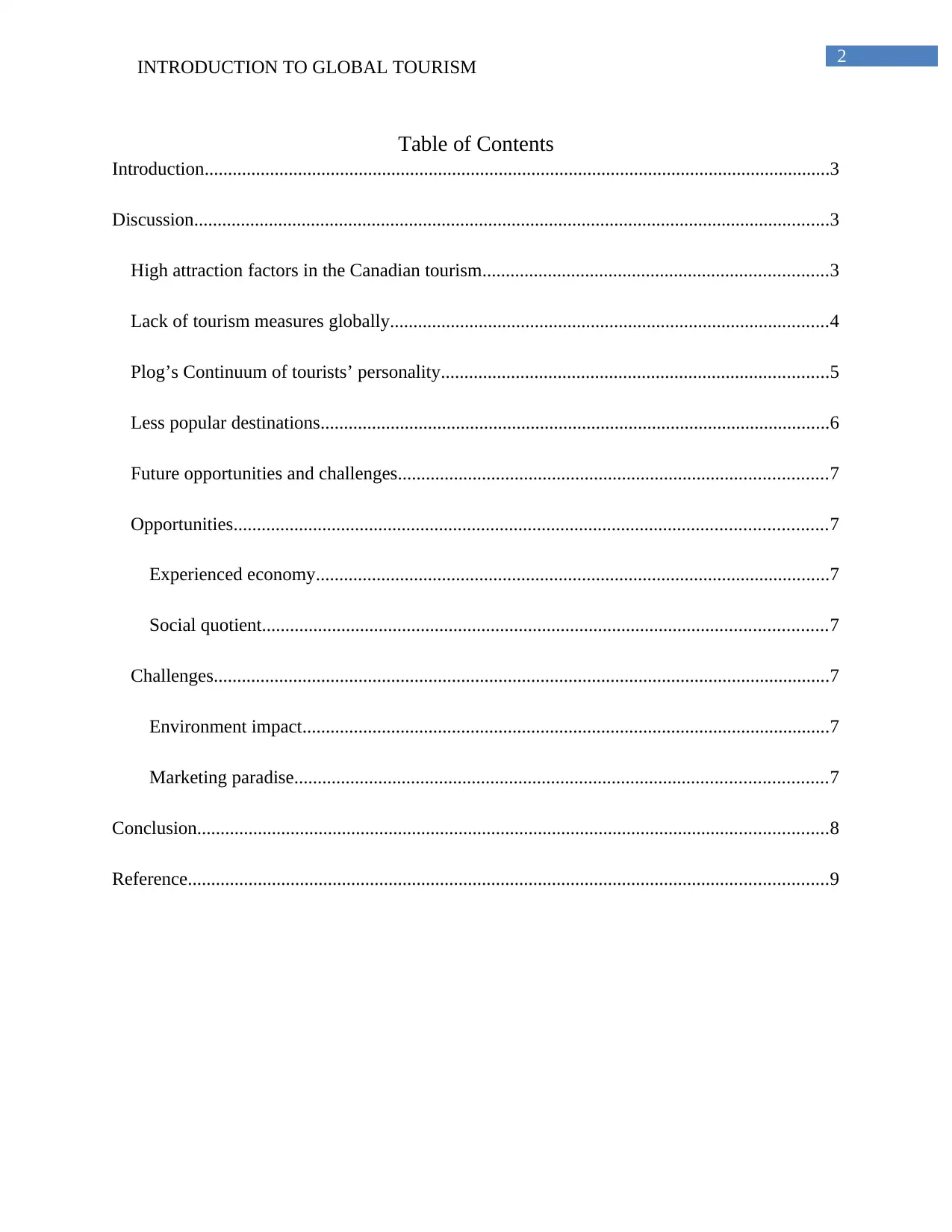
2
INTRODUCTION TO GLOBAL TOURISM
Table of Contents
Introduction......................................................................................................................................3
Discussion........................................................................................................................................3
High attraction factors in the Canadian tourism..........................................................................3
Lack of tourism measures globally..............................................................................................4
Plog’s Continuum of tourists’ personality...................................................................................5
Less popular destinations.............................................................................................................6
Future opportunities and challenges............................................................................................7
Opportunities...............................................................................................................................7
Experienced economy..............................................................................................................7
Social quotient.........................................................................................................................7
Challenges....................................................................................................................................7
Environment impact.................................................................................................................7
Marketing paradise..................................................................................................................7
Conclusion.......................................................................................................................................8
Reference.........................................................................................................................................9
INTRODUCTION TO GLOBAL TOURISM
Table of Contents
Introduction......................................................................................................................................3
Discussion........................................................................................................................................3
High attraction factors in the Canadian tourism..........................................................................3
Lack of tourism measures globally..............................................................................................4
Plog’s Continuum of tourists’ personality...................................................................................5
Less popular destinations.............................................................................................................6
Future opportunities and challenges............................................................................................7
Opportunities...............................................................................................................................7
Experienced economy..............................................................................................................7
Social quotient.........................................................................................................................7
Challenges....................................................................................................................................7
Environment impact.................................................................................................................7
Marketing paradise..................................................................................................................7
Conclusion.......................................................................................................................................8
Reference.........................................................................................................................................9
⊘ This is a preview!⊘
Do you want full access?
Subscribe today to unlock all pages.

Trusted by 1+ million students worldwide
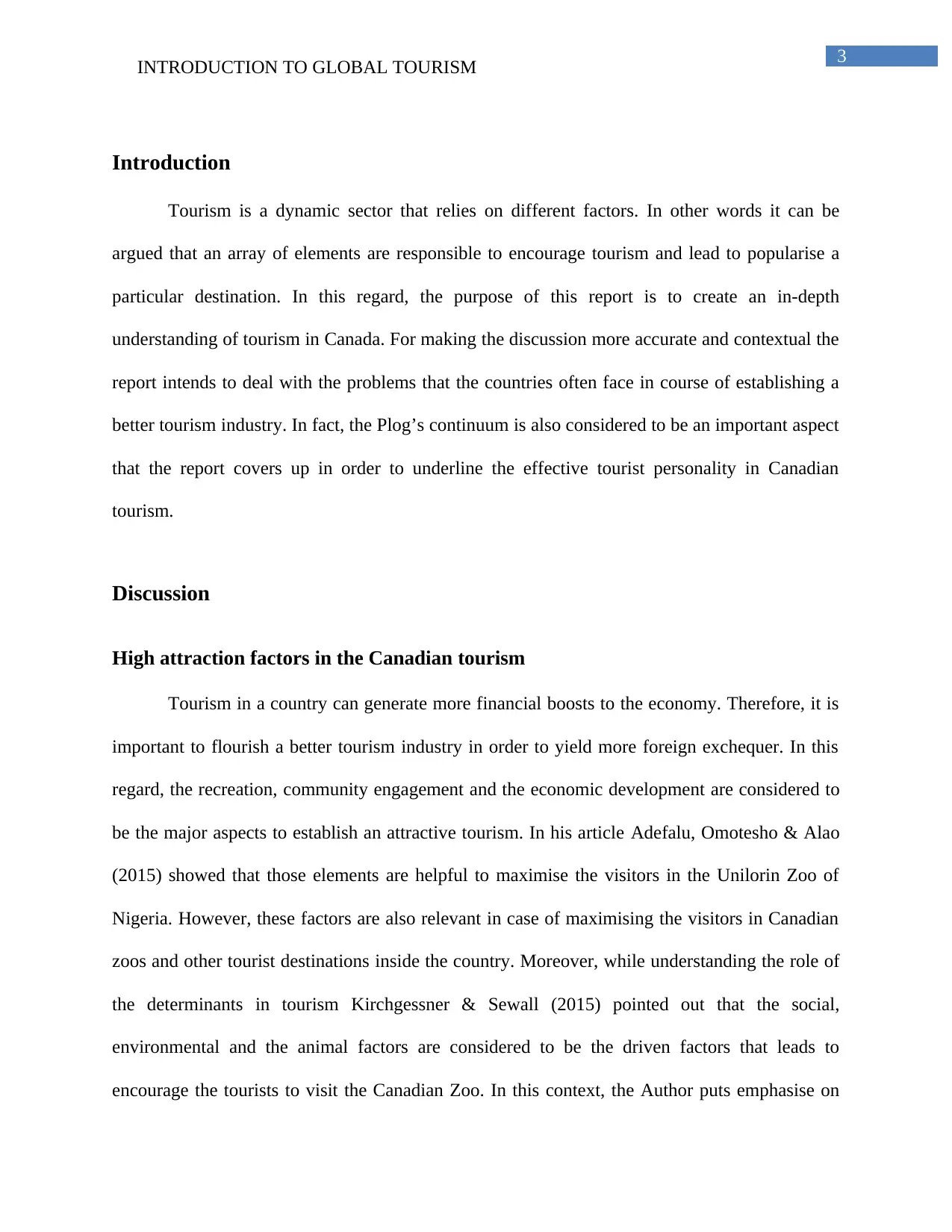
3
INTRODUCTION TO GLOBAL TOURISM
Introduction
Tourism is a dynamic sector that relies on different factors. In other words it can be
argued that an array of elements are responsible to encourage tourism and lead to popularise a
particular destination. In this regard, the purpose of this report is to create an in-depth
understanding of tourism in Canada. For making the discussion more accurate and contextual the
report intends to deal with the problems that the countries often face in course of establishing a
better tourism industry. In fact, the Plog’s continuum is also considered to be an important aspect
that the report covers up in order to underline the effective tourist personality in Canadian
tourism.
Discussion
High attraction factors in the Canadian tourism
Tourism in a country can generate more financial boosts to the economy. Therefore, it is
important to flourish a better tourism industry in order to yield more foreign exchequer. In this
regard, the recreation, community engagement and the economic development are considered to
be the major aspects to establish an attractive tourism. In his article Adefalu, Omotesho & Alao
(2015) showed that those elements are helpful to maximise the visitors in the Unilorin Zoo of
Nigeria. However, these factors are also relevant in case of maximising the visitors in Canadian
zoos and other tourist destinations inside the country. Moreover, while understanding the role of
the determinants in tourism Kirchgessner & Sewall (2015) pointed out that the social,
environmental and the animal factors are considered to be the driven factors that leads to
encourage the tourists to visit the Canadian Zoo. In this context, the Author puts emphasise on
INTRODUCTION TO GLOBAL TOURISM
Introduction
Tourism is a dynamic sector that relies on different factors. In other words it can be
argued that an array of elements are responsible to encourage tourism and lead to popularise a
particular destination. In this regard, the purpose of this report is to create an in-depth
understanding of tourism in Canada. For making the discussion more accurate and contextual the
report intends to deal with the problems that the countries often face in course of establishing a
better tourism industry. In fact, the Plog’s continuum is also considered to be an important aspect
that the report covers up in order to underline the effective tourist personality in Canadian
tourism.
Discussion
High attraction factors in the Canadian tourism
Tourism in a country can generate more financial boosts to the economy. Therefore, it is
important to flourish a better tourism industry in order to yield more foreign exchequer. In this
regard, the recreation, community engagement and the economic development are considered to
be the major aspects to establish an attractive tourism. In his article Adefalu, Omotesho & Alao
(2015) showed that those elements are helpful to maximise the visitors in the Unilorin Zoo of
Nigeria. However, these factors are also relevant in case of maximising the visitors in Canadian
zoos and other tourist destinations inside the country. Moreover, while understanding the role of
the determinants in tourism Kirchgessner & Sewall (2015) pointed out that the social,
environmental and the animal factors are considered to be the driven factors that leads to
encourage the tourists to visit the Canadian Zoo. In this context, the Author puts emphasise on
Paraphrase This Document
Need a fresh take? Get an instant paraphrase of this document with our AI Paraphraser
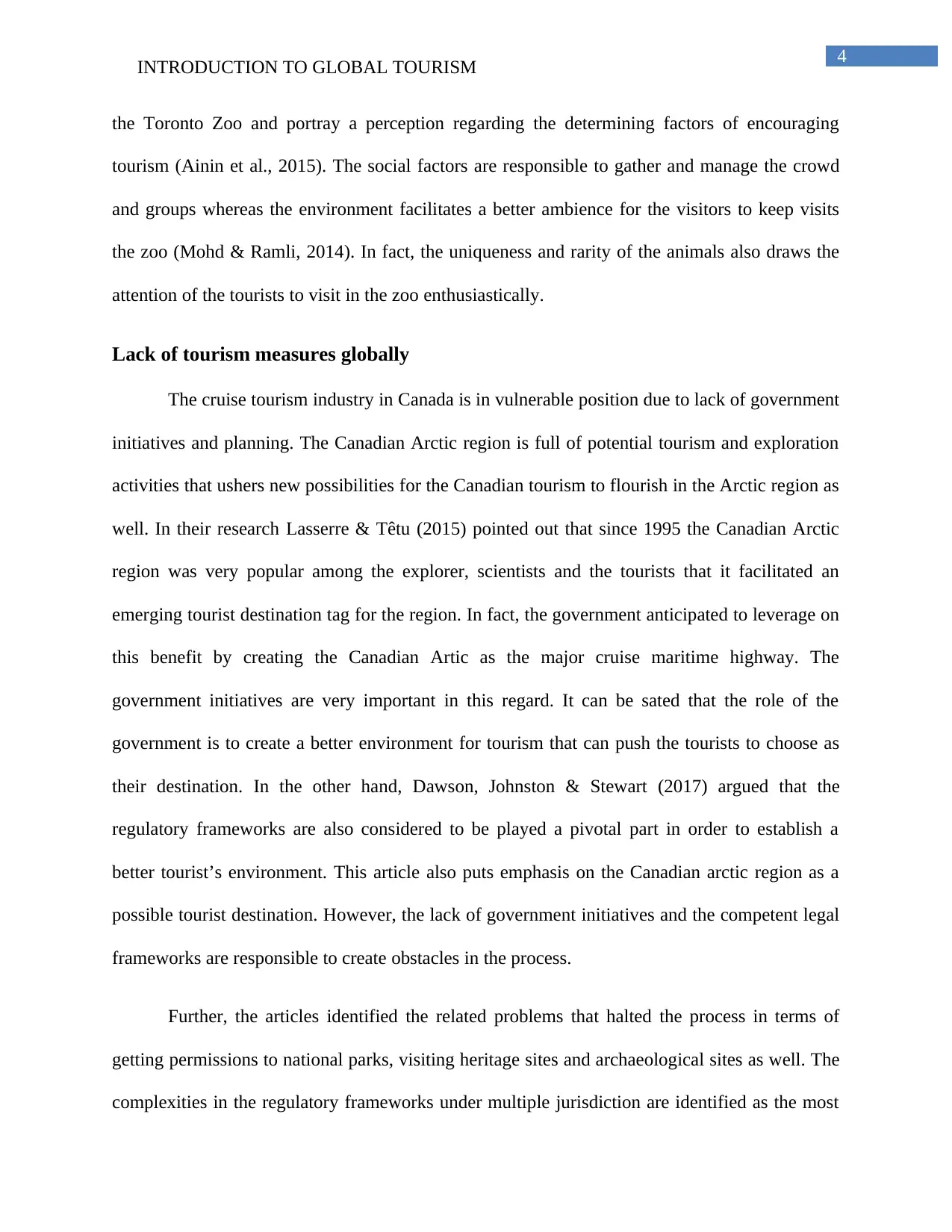
4
INTRODUCTION TO GLOBAL TOURISM
the Toronto Zoo and portray a perception regarding the determining factors of encouraging
tourism (Ainin et al., 2015). The social factors are responsible to gather and manage the crowd
and groups whereas the environment facilitates a better ambience for the visitors to keep visits
the zoo (Mohd & Ramli, 2014). In fact, the uniqueness and rarity of the animals also draws the
attention of the tourists to visit in the zoo enthusiastically.
Lack of tourism measures globally
The cruise tourism industry in Canada is in vulnerable position due to lack of government
initiatives and planning. The Canadian Arctic region is full of potential tourism and exploration
activities that ushers new possibilities for the Canadian tourism to flourish in the Arctic region as
well. In their research Lasserre & Têtu (2015) pointed out that since 1995 the Canadian Arctic
region was very popular among the explorer, scientists and the tourists that it facilitated an
emerging tourist destination tag for the region. In fact, the government anticipated to leverage on
this benefit by creating the Canadian Artic as the major cruise maritime highway. The
government initiatives are very important in this regard. It can be sated that the role of the
government is to create a better environment for tourism that can push the tourists to choose as
their destination. In the other hand, Dawson, Johnston & Stewart (2017) argued that the
regulatory frameworks are also considered to be played a pivotal part in order to establish a
better tourist’s environment. This article also puts emphasis on the Canadian arctic region as a
possible tourist destination. However, the lack of government initiatives and the competent legal
frameworks are responsible to create obstacles in the process.
Further, the articles identified the related problems that halted the process in terms of
getting permissions to national parks, visiting heritage sites and archaeological sites as well. The
complexities in the regulatory frameworks under multiple jurisdiction are identified as the most
INTRODUCTION TO GLOBAL TOURISM
the Toronto Zoo and portray a perception regarding the determining factors of encouraging
tourism (Ainin et al., 2015). The social factors are responsible to gather and manage the crowd
and groups whereas the environment facilitates a better ambience for the visitors to keep visits
the zoo (Mohd & Ramli, 2014). In fact, the uniqueness and rarity of the animals also draws the
attention of the tourists to visit in the zoo enthusiastically.
Lack of tourism measures globally
The cruise tourism industry in Canada is in vulnerable position due to lack of government
initiatives and planning. The Canadian Arctic region is full of potential tourism and exploration
activities that ushers new possibilities for the Canadian tourism to flourish in the Arctic region as
well. In their research Lasserre & Têtu (2015) pointed out that since 1995 the Canadian Arctic
region was very popular among the explorer, scientists and the tourists that it facilitated an
emerging tourist destination tag for the region. In fact, the government anticipated to leverage on
this benefit by creating the Canadian Artic as the major cruise maritime highway. The
government initiatives are very important in this regard. It can be sated that the role of the
government is to create a better environment for tourism that can push the tourists to choose as
their destination. In the other hand, Dawson, Johnston & Stewart (2017) argued that the
regulatory frameworks are also considered to be played a pivotal part in order to establish a
better tourist’s environment. This article also puts emphasis on the Canadian arctic region as a
possible tourist destination. However, the lack of government initiatives and the competent legal
frameworks are responsible to create obstacles in the process.
Further, the articles identified the related problems that halted the process in terms of
getting permissions to national parks, visiting heritage sites and archaeological sites as well. The
complexities in the regulatory frameworks under multiple jurisdiction are identified as the most
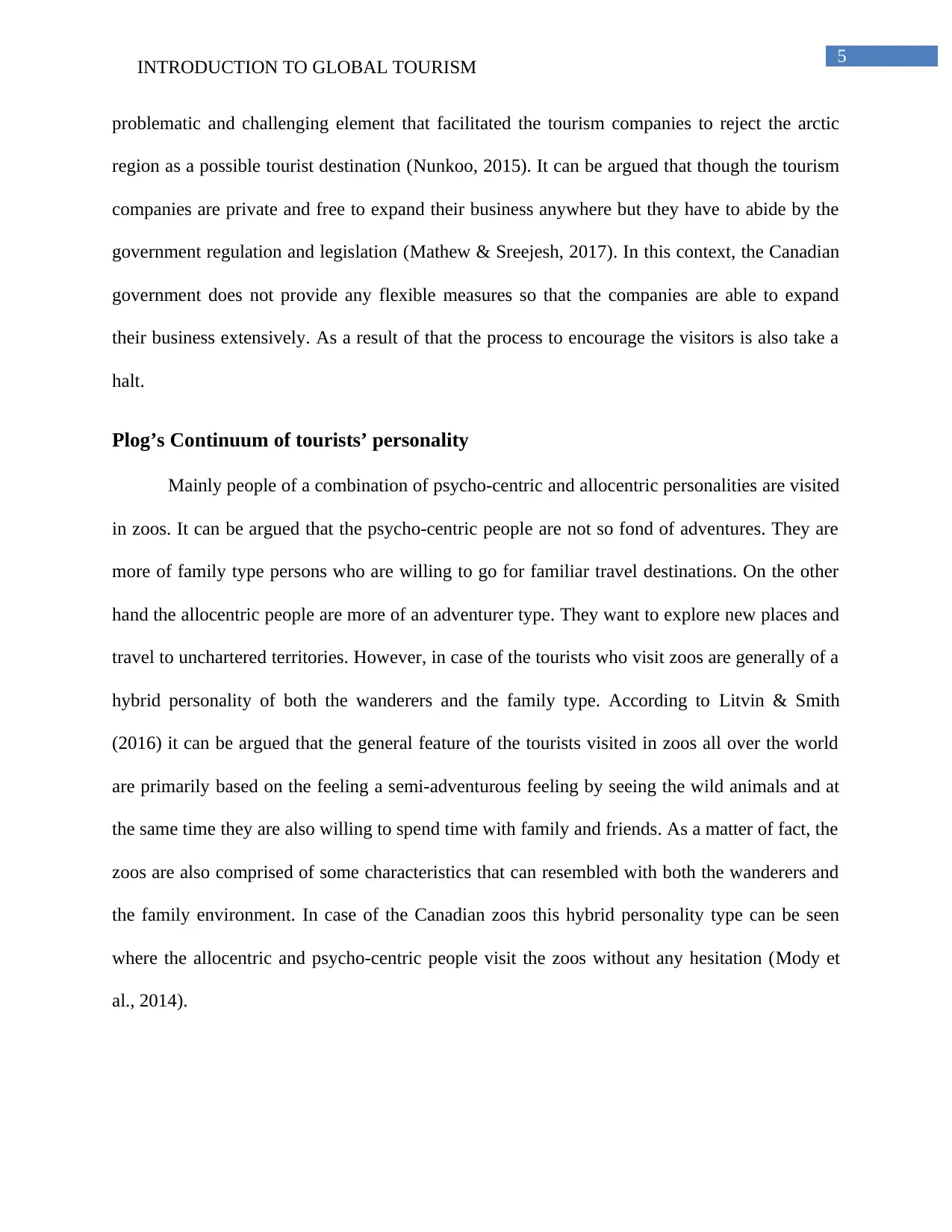
5
INTRODUCTION TO GLOBAL TOURISM
problematic and challenging element that facilitated the tourism companies to reject the arctic
region as a possible tourist destination (Nunkoo, 2015). It can be argued that though the tourism
companies are private and free to expand their business anywhere but they have to abide by the
government regulation and legislation (Mathew & Sreejesh, 2017). In this context, the Canadian
government does not provide any flexible measures so that the companies are able to expand
their business extensively. As a result of that the process to encourage the visitors is also take a
halt.
Plog’s Continuum of tourists’ personality
Mainly people of a combination of psycho-centric and allocentric personalities are visited
in zoos. It can be argued that the psycho-centric people are not so fond of adventures. They are
more of family type persons who are willing to go for familiar travel destinations. On the other
hand the allocentric people are more of an adventurer type. They want to explore new places and
travel to unchartered territories. However, in case of the tourists who visit zoos are generally of a
hybrid personality of both the wanderers and the family type. According to Litvin & Smith
(2016) it can be argued that the general feature of the tourists visited in zoos all over the world
are primarily based on the feeling a semi-adventurous feeling by seeing the wild animals and at
the same time they are also willing to spend time with family and friends. As a matter of fact, the
zoos are also comprised of some characteristics that can resembled with both the wanderers and
the family environment. In case of the Canadian zoos this hybrid personality type can be seen
where the allocentric and psycho-centric people visit the zoos without any hesitation (Mody et
al., 2014).
INTRODUCTION TO GLOBAL TOURISM
problematic and challenging element that facilitated the tourism companies to reject the arctic
region as a possible tourist destination (Nunkoo, 2015). It can be argued that though the tourism
companies are private and free to expand their business anywhere but they have to abide by the
government regulation and legislation (Mathew & Sreejesh, 2017). In this context, the Canadian
government does not provide any flexible measures so that the companies are able to expand
their business extensively. As a result of that the process to encourage the visitors is also take a
halt.
Plog’s Continuum of tourists’ personality
Mainly people of a combination of psycho-centric and allocentric personalities are visited
in zoos. It can be argued that the psycho-centric people are not so fond of adventures. They are
more of family type persons who are willing to go for familiar travel destinations. On the other
hand the allocentric people are more of an adventurer type. They want to explore new places and
travel to unchartered territories. However, in case of the tourists who visit zoos are generally of a
hybrid personality of both the wanderers and the family type. According to Litvin & Smith
(2016) it can be argued that the general feature of the tourists visited in zoos all over the world
are primarily based on the feeling a semi-adventurous feeling by seeing the wild animals and at
the same time they are also willing to spend time with family and friends. As a matter of fact, the
zoos are also comprised of some characteristics that can resembled with both the wanderers and
the family environment. In case of the Canadian zoos this hybrid personality type can be seen
where the allocentric and psycho-centric people visit the zoos without any hesitation (Mody et
al., 2014).
⊘ This is a preview!⊘
Do you want full access?
Subscribe today to unlock all pages.

Trusted by 1+ million students worldwide
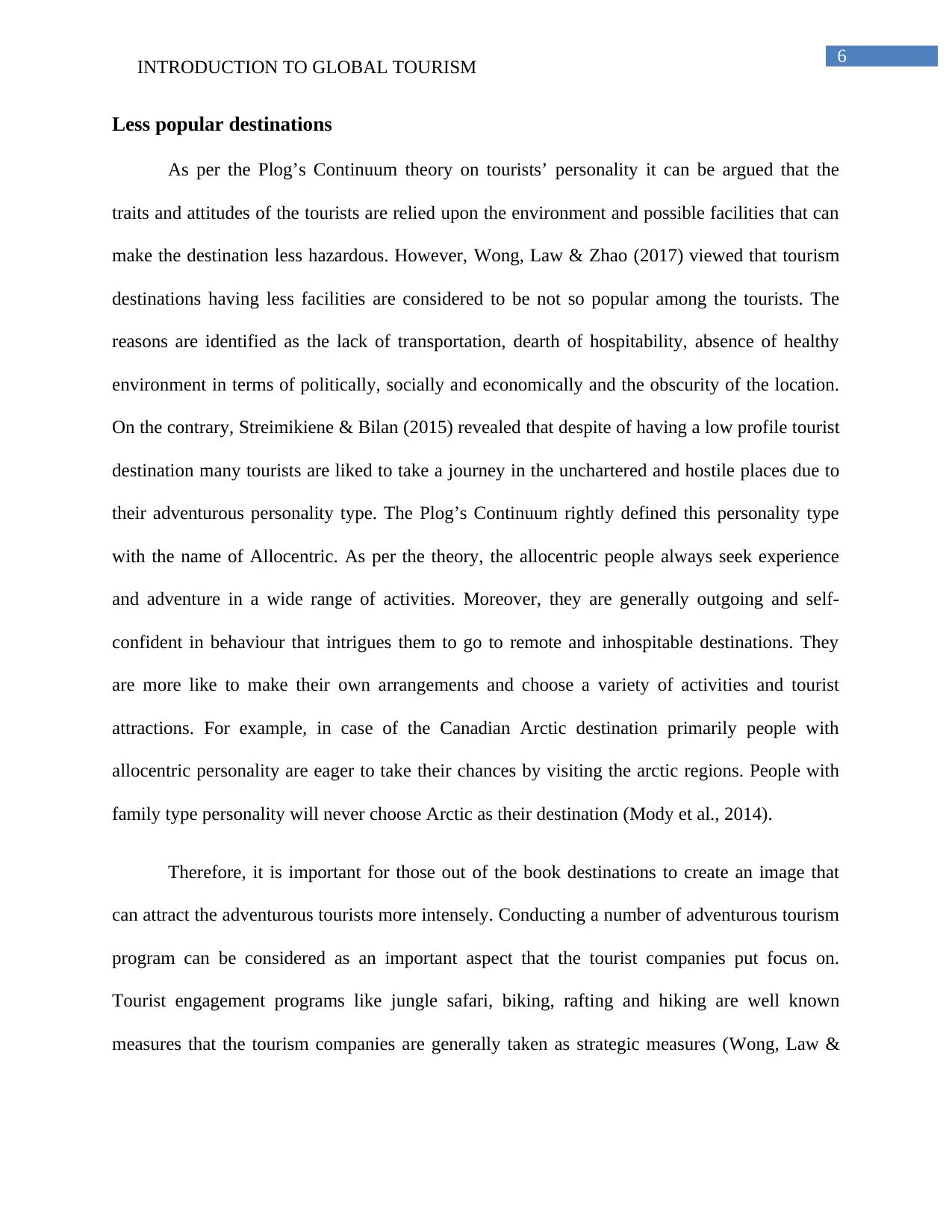
6
INTRODUCTION TO GLOBAL TOURISM
Less popular destinations
As per the Plog’s Continuum theory on tourists’ personality it can be argued that the
traits and attitudes of the tourists are relied upon the environment and possible facilities that can
make the destination less hazardous. However, Wong, Law & Zhao (2017) viewed that tourism
destinations having less facilities are considered to be not so popular among the tourists. The
reasons are identified as the lack of transportation, dearth of hospitability, absence of healthy
environment in terms of politically, socially and economically and the obscurity of the location.
On the contrary, Streimikiene & Bilan (2015) revealed that despite of having a low profile tourist
destination many tourists are liked to take a journey in the unchartered and hostile places due to
their adventurous personality type. The Plog’s Continuum rightly defined this personality type
with the name of Allocentric. As per the theory, the allocentric people always seek experience
and adventure in a wide range of activities. Moreover, they are generally outgoing and self-
confident in behaviour that intrigues them to go to remote and inhospitable destinations. They
are more like to make their own arrangements and choose a variety of activities and tourist
attractions. For example, in case of the Canadian Arctic destination primarily people with
allocentric personality are eager to take their chances by visiting the arctic regions. People with
family type personality will never choose Arctic as their destination (Mody et al., 2014).
Therefore, it is important for those out of the book destinations to create an image that
can attract the adventurous tourists more intensely. Conducting a number of adventurous tourism
program can be considered as an important aspect that the tourist companies put focus on.
Tourist engagement programs like jungle safari, biking, rafting and hiking are well known
measures that the tourism companies are generally taken as strategic measures (Wong, Law &
INTRODUCTION TO GLOBAL TOURISM
Less popular destinations
As per the Plog’s Continuum theory on tourists’ personality it can be argued that the
traits and attitudes of the tourists are relied upon the environment and possible facilities that can
make the destination less hazardous. However, Wong, Law & Zhao (2017) viewed that tourism
destinations having less facilities are considered to be not so popular among the tourists. The
reasons are identified as the lack of transportation, dearth of hospitability, absence of healthy
environment in terms of politically, socially and economically and the obscurity of the location.
On the contrary, Streimikiene & Bilan (2015) revealed that despite of having a low profile tourist
destination many tourists are liked to take a journey in the unchartered and hostile places due to
their adventurous personality type. The Plog’s Continuum rightly defined this personality type
with the name of Allocentric. As per the theory, the allocentric people always seek experience
and adventure in a wide range of activities. Moreover, they are generally outgoing and self-
confident in behaviour that intrigues them to go to remote and inhospitable destinations. They
are more like to make their own arrangements and choose a variety of activities and tourist
attractions. For example, in case of the Canadian Arctic destination primarily people with
allocentric personality are eager to take their chances by visiting the arctic regions. People with
family type personality will never choose Arctic as their destination (Mody et al., 2014).
Therefore, it is important for those out of the book destinations to create an image that
can attract the adventurous tourists more intensely. Conducting a number of adventurous tourism
program can be considered as an important aspect that the tourist companies put focus on.
Tourist engagement programs like jungle safari, biking, rafting and hiking are well known
measures that the tourism companies are generally taken as strategic measures (Wong, Law &
Paraphrase This Document
Need a fresh take? Get an instant paraphrase of this document with our AI Paraphraser
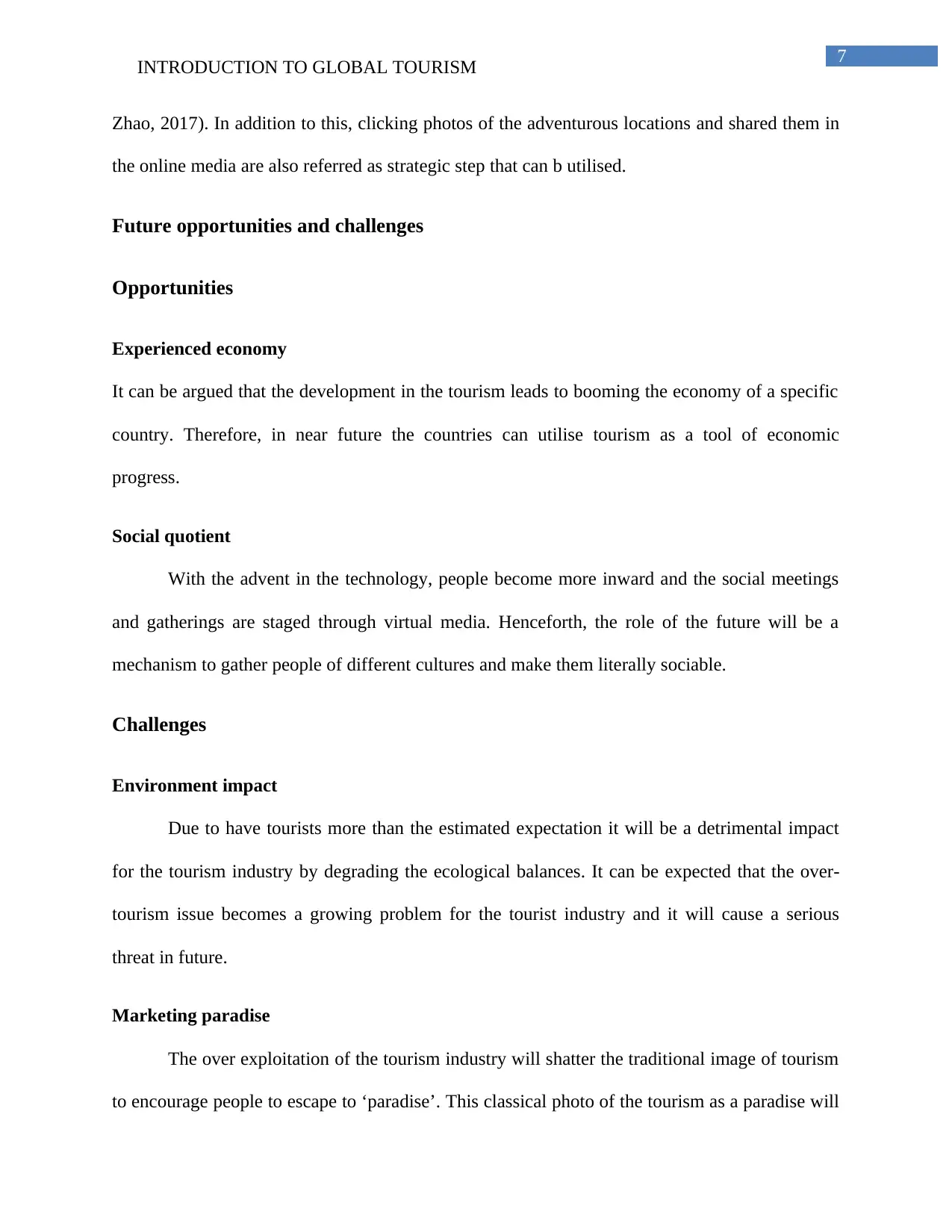
7
INTRODUCTION TO GLOBAL TOURISM
Zhao, 2017). In addition to this, clicking photos of the adventurous locations and shared them in
the online media are also referred as strategic step that can b utilised.
Future opportunities and challenges
Opportunities
Experienced economy
It can be argued that the development in the tourism leads to booming the economy of a specific
country. Therefore, in near future the countries can utilise tourism as a tool of economic
progress.
Social quotient
With the advent in the technology, people become more inward and the social meetings
and gatherings are staged through virtual media. Henceforth, the role of the future will be a
mechanism to gather people of different cultures and make them literally sociable.
Challenges
Environment impact
Due to have tourists more than the estimated expectation it will be a detrimental impact
for the tourism industry by degrading the ecological balances. It can be expected that the over-
tourism issue becomes a growing problem for the tourist industry and it will cause a serious
threat in future.
Marketing paradise
The over exploitation of the tourism industry will shatter the traditional image of tourism
to encourage people to escape to ‘paradise’. This classical photo of the tourism as a paradise will
INTRODUCTION TO GLOBAL TOURISM
Zhao, 2017). In addition to this, clicking photos of the adventurous locations and shared them in
the online media are also referred as strategic step that can b utilised.
Future opportunities and challenges
Opportunities
Experienced economy
It can be argued that the development in the tourism leads to booming the economy of a specific
country. Therefore, in near future the countries can utilise tourism as a tool of economic
progress.
Social quotient
With the advent in the technology, people become more inward and the social meetings
and gatherings are staged through virtual media. Henceforth, the role of the future will be a
mechanism to gather people of different cultures and make them literally sociable.
Challenges
Environment impact
Due to have tourists more than the estimated expectation it will be a detrimental impact
for the tourism industry by degrading the ecological balances. It can be expected that the over-
tourism issue becomes a growing problem for the tourist industry and it will cause a serious
threat in future.
Marketing paradise
The over exploitation of the tourism industry will shatter the traditional image of tourism
to encourage people to escape to ‘paradise’. This classical photo of the tourism as a paradise will

8
INTRODUCTION TO GLOBAL TOURISM
be terminated by the visitors as people are aware about the environmental degradation caused by
the tourist companies.
Conclusion
It can be concluded that there are a number of factors that are responsible to sustain
tourism globally. In this regard, the environmental, social and the behaviour of the tourists are
considered to be the most important aspects that determines the future of global tourism.
However, lack of government initiatives and the complexities in the regulatory framework can
create enormous problem regarding the sustainable expansion of tourism across the world.
Despite of that it can be argued that there are high chance and opportunity for the global tourism
industry to foster a better condition by incorporating all the influencing factors that left impact
on the global tourism sustainability.
INTRODUCTION TO GLOBAL TOURISM
be terminated by the visitors as people are aware about the environmental degradation caused by
the tourist companies.
Conclusion
It can be concluded that there are a number of factors that are responsible to sustain
tourism globally. In this regard, the environmental, social and the behaviour of the tourists are
considered to be the most important aspects that determines the future of global tourism.
However, lack of government initiatives and the complexities in the regulatory framework can
create enormous problem regarding the sustainable expansion of tourism across the world.
Despite of that it can be argued that there are high chance and opportunity for the global tourism
industry to foster a better condition by incorporating all the influencing factors that left impact
on the global tourism sustainability.
⊘ This is a preview!⊘
Do you want full access?
Subscribe today to unlock all pages.

Trusted by 1+ million students worldwide
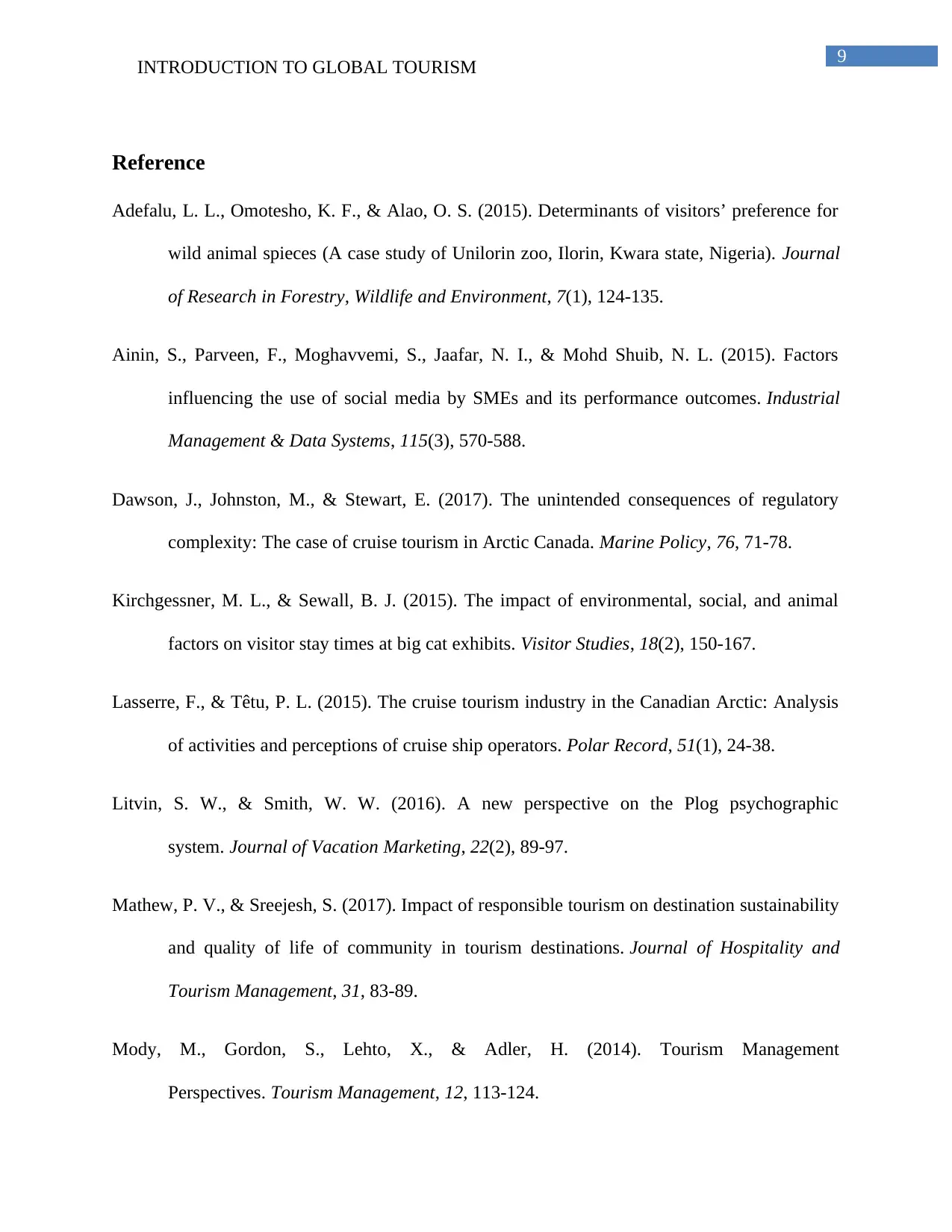
9
INTRODUCTION TO GLOBAL TOURISM
Reference
Adefalu, L. L., Omotesho, K. F., & Alao, O. S. (2015). Determinants of visitors’ preference for
wild animal spieces (A case study of Unilorin zoo, Ilorin, Kwara state, Nigeria). Journal
of Research in Forestry, Wildlife and Environment, 7(1), 124-135.
Ainin, S., Parveen, F., Moghavvemi, S., Jaafar, N. I., & Mohd Shuib, N. L. (2015). Factors
influencing the use of social media by SMEs and its performance outcomes. Industrial
Management & Data Systems, 115(3), 570-588.
Dawson, J., Johnston, M., & Stewart, E. (2017). The unintended consequences of regulatory
complexity: The case of cruise tourism in Arctic Canada. Marine Policy, 76, 71-78.
Kirchgessner, M. L., & Sewall, B. J. (2015). The impact of environmental, social, and animal
factors on visitor stay times at big cat exhibits. Visitor Studies, 18(2), 150-167.
Lasserre, F., & Têtu, P. L. (2015). The cruise tourism industry in the Canadian Arctic: Analysis
of activities and perceptions of cruise ship operators. Polar Record, 51(1), 24-38.
Litvin, S. W., & Smith, W. W. (2016). A new perspective on the Plog psychographic
system. Journal of Vacation Marketing, 22(2), 89-97.
Mathew, P. V., & Sreejesh, S. (2017). Impact of responsible tourism on destination sustainability
and quality of life of community in tourism destinations. Journal of Hospitality and
Tourism Management, 31, 83-89.
Mody, M., Gordon, S., Lehto, X., & Adler, H. (2014). Tourism Management
Perspectives. Tourism Management, 12, 113-124.
INTRODUCTION TO GLOBAL TOURISM
Reference
Adefalu, L. L., Omotesho, K. F., & Alao, O. S. (2015). Determinants of visitors’ preference for
wild animal spieces (A case study of Unilorin zoo, Ilorin, Kwara state, Nigeria). Journal
of Research in Forestry, Wildlife and Environment, 7(1), 124-135.
Ainin, S., Parveen, F., Moghavvemi, S., Jaafar, N. I., & Mohd Shuib, N. L. (2015). Factors
influencing the use of social media by SMEs and its performance outcomes. Industrial
Management & Data Systems, 115(3), 570-588.
Dawson, J., Johnston, M., & Stewart, E. (2017). The unintended consequences of regulatory
complexity: The case of cruise tourism in Arctic Canada. Marine Policy, 76, 71-78.
Kirchgessner, M. L., & Sewall, B. J. (2015). The impact of environmental, social, and animal
factors on visitor stay times at big cat exhibits. Visitor Studies, 18(2), 150-167.
Lasserre, F., & Têtu, P. L. (2015). The cruise tourism industry in the Canadian Arctic: Analysis
of activities and perceptions of cruise ship operators. Polar Record, 51(1), 24-38.
Litvin, S. W., & Smith, W. W. (2016). A new perspective on the Plog psychographic
system. Journal of Vacation Marketing, 22(2), 89-97.
Mathew, P. V., & Sreejesh, S. (2017). Impact of responsible tourism on destination sustainability
and quality of life of community in tourism destinations. Journal of Hospitality and
Tourism Management, 31, 83-89.
Mody, M., Gordon, S., Lehto, X., & Adler, H. (2014). Tourism Management
Perspectives. Tourism Management, 12, 113-124.
Paraphrase This Document
Need a fresh take? Get an instant paraphrase of this document with our AI Paraphraser
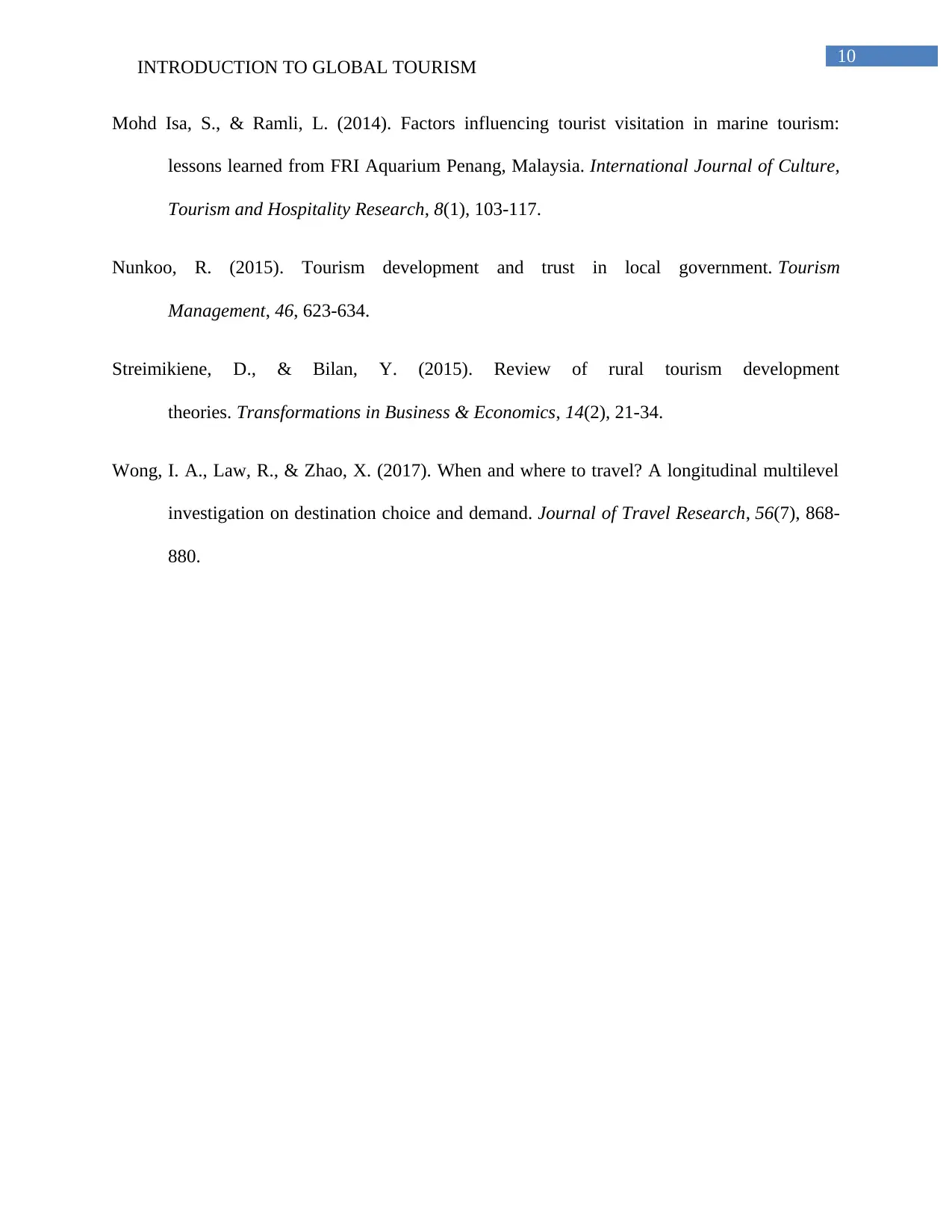
10
INTRODUCTION TO GLOBAL TOURISM
Mohd Isa, S., & Ramli, L. (2014). Factors influencing tourist visitation in marine tourism:
lessons learned from FRI Aquarium Penang, Malaysia. International Journal of Culture,
Tourism and Hospitality Research, 8(1), 103-117.
Nunkoo, R. (2015). Tourism development and trust in local government. Tourism
Management, 46, 623-634.
Streimikiene, D., & Bilan, Y. (2015). Review of rural tourism development
theories. Transformations in Business & Economics, 14(2), 21-34.
Wong, I. A., Law, R., & Zhao, X. (2017). When and where to travel? A longitudinal multilevel
investigation on destination choice and demand. Journal of Travel Research, 56(7), 868-
880.
INTRODUCTION TO GLOBAL TOURISM
Mohd Isa, S., & Ramli, L. (2014). Factors influencing tourist visitation in marine tourism:
lessons learned from FRI Aquarium Penang, Malaysia. International Journal of Culture,
Tourism and Hospitality Research, 8(1), 103-117.
Nunkoo, R. (2015). Tourism development and trust in local government. Tourism
Management, 46, 623-634.
Streimikiene, D., & Bilan, Y. (2015). Review of rural tourism development
theories. Transformations in Business & Economics, 14(2), 21-34.
Wong, I. A., Law, R., & Zhao, X. (2017). When and where to travel? A longitudinal multilevel
investigation on destination choice and demand. Journal of Travel Research, 56(7), 868-
880.
1 out of 11
Related Documents
Your All-in-One AI-Powered Toolkit for Academic Success.
+13062052269
info@desklib.com
Available 24*7 on WhatsApp / Email
![[object Object]](/_next/static/media/star-bottom.7253800d.svg)
Unlock your academic potential
Copyright © 2020–2025 A2Z Services. All Rights Reserved. Developed and managed by ZUCOL.





